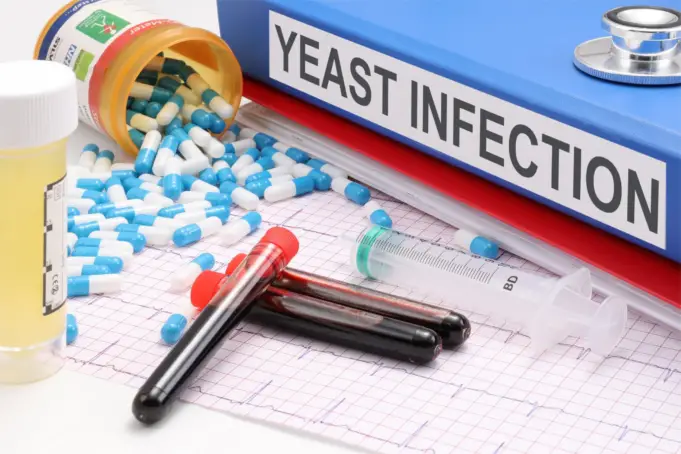Yeast infections occur when an overgrowth of the Candida fungus grows in the body. Vaginal yeast infections are most common, although may occur in the mouth, throat, skin folds, and other areas. Treating a yeast infection via over-the-counter medications is possible, although if you’re a first-timer, visit a physician. A medical doctor can rule out other health conditions and confirm a yeast infection diagnosis.
How to Treat a Yeast Infection
Doctors generally prescribe antifungal medications to patients diagnosed with yeast infections. The same medications are sold at drugstores without a prescription, although likely provide less effective results than prescription products. Anti-fungal medications take an average of 7 days to cure the infection, although the exact time it takes depends on many factors.
Lifestyle changes can also help ward off future occurrences of yeast infections.
Treatment options include:
Over-the-counter antifungal creams or suppositories: These can be purchased at a drugstore without a prescription and are often used to treat vaginal yeast infections. They contain medication such as miconazole or clotrimazole, which can help to kill the Candida fungus and relieve symptoms such as itching and discharge.
- Prescription antifungal medication: If over-the-counter treatments are ineffective, a healthcare provider may prescribe a stronger antifungal medication such as fluconazole. The medication is available in oral form or as a vaginal suppository, depending on the location of the yeast infection.
- Probiotics: Probiotics are live microorganisms that can help to restore the natural balance of bacteria in the body. They are available in supplement form and can be found in certain foods, such as yogurt. Some studies suggest that probiotics may help to prevent and treat yeast infections.
- Avoiding irritants: Certain products and activities can irritate the area affected by a yeast infection, making the symptoms worse. Avoiding scented products, tight clothing, and douching are some of the ways to reduce irritation and prevent future infections.
Understanding Antifungal Medications
Antifungal medications are a class of drugs used to treat infections caused by fungi. They work by killing the fungi or stopping them from growing and reproducing. There are several types of antifungal medications, and the specific medication needed depends on the type of fungal infection and the severity of the infection. The most common types of antifungal medications include:
- Azoles: Azoles are a type of antifungal medication that works by inhibiting the synthesis of ergosterol, a key component of the fungal cell membrane. Some common azoles include fluconazole, itraconazole, and ketoconazole.
- Polyenes: Polyenes are a type of antifungal medication that works by binding to the fungal cell membrane and causing it to become leaky. This allows essential molecules to leak out of the cell, leading to the death of the fungus. Amphotericin B is a common polyene medication.
- Echinocandins: Echinocandins are a type of antifungal medication that works by inhibiting the synthesis of beta-glucan, an essential component of the fungal cell wall. Caspofungin and micafungin are common echinocandin medications.
- Allylamines: Allylamines are a type of antifungal medication that works by inhibiting the synthesis of ergosterol, a key component of the fungal cell membrane. Terbinafine is a common allylamine medication.
Antifungal medications are available in various forms, including oral tablets, creams, ointments, and intravenous injections. The specific type of medication needed depends on the type and severity of the fungal infection. Find them at the lowest costs at https://hellowisp.com/. Getting rid of yeast infections requires the completion of the medication. Completing all of the medication is important, even if the symptoms disappear. Failing to complete the entire course of treatment may cause bacteria regrowth and the onset of another yeast infection.
Treating Yeast Infections With Probiotics
Probiotics are live microorganisms believed to provide health benefits when consumed. The most commonly studied types of probiotics are bacteria from the genera Lactobacillus and Bifidobacterium. Probiotics are found in certain foods and are available in supplement form. Yogurt, kefir, sauerkraut, and kimchi are common probiotic-rich foods.
Probiotics work by helping to restore the natural balance of bacteria in the gut, which can be disrupted by factors such as antibiotic use, stress, and poor diet. They can also help to improve digestive function, boost the immune system, and reduce inflammation.
Some of the specific health benefits that have been associated with probiotics include:
- Improved digestive function: Probiotics can help improve the balance of bacteria in the gut. Reducing gut bacteria can improve digestive function and reduce symptoms such as diarrhea and constipation.
- Enhanced immune function: Probiotics have been shown to stimulate the immune system and help to protect against infections.
- Reduced inflammation: Probiotics can help to reduce inflammation in the gut and throughout the body, which can help to reduce the risk of chronic diseases such as heart disease, diabetes, and cancer.
- Improved mental health: Some research has suggested that probiotics may help to improve mood and reduce symptoms of anxiety and depression.
It is important to note that while probiotics are generally considered safe, they may not be appropriate for everyone. People with weakened immune systems, severe illnesses, or other medical conditions should consult their healthcare provider before taking probiotics.
Irritants That May Cause Yeast Infections
Yeast infections are caused by an overgrowth of the fungus Candida albicans, which is naturally present in the body but can multiply in certain conditions. Some irritants that can contribute to the development of yeast infections include:
- Antibiotics – Work to kill off the “good” bacteria in the body that help keep Candida albicans in check, leading to an overgrowth of yeast.
- Hormonal changes – Changes in hormones, such as those that occur during pregnancy, menstruation, or menopause, can disrupt the natural balance of bacteria and yeast in the body.
- Tight clothing – Wearing tight clothing, especially in the genital area, can create a warm and moist environment that is conducive to yeast growth.
- Harsh soaps or hygiene products – Using harsh soaps or other hygiene products that contain fragrances, dyes, or other irritants can disrupt the natural pH balance of the vagina and increase the risk of yeast infections.
- High-sugar diets – Consuming a diet high in sugar and carbohydrates can promote yeast growth in the body.
It is important to note that while irritants can contribute to the development of yeast infections, other factors such as a weakened immune system or certain medical conditions can also play a role. If you suspect you have a yeast infection, it is best to consult a healthcare provider for proper diagnosis and treatment.












